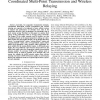Free Online Productivity Tools
i2Speak
i2Symbol
i2OCR
iTex2Img
iWeb2Print
iWeb2Shot
i2Type
iPdf2Split
iPdf2Merge
i2Bopomofo
i2Arabic
i2Style
i2Image
i2PDF
iLatex2Rtf
Sci2ools
GLOBECOM
2010
IEEE
2010
IEEE
Energy Saving Performance Comparison of Coordinated Multi-Point Transmission and Wireless Relaying
Currently, two cooperative transmission strategies, Coordinated Multi-Point (CoMP) Transmission and wireless relaying, are expected to be deployed in future cellular systems to improve the performance of cell-edge users. Due to the cooperation diversity, these technologies can potentially lead to more energy saving. Therefore in this paper, we analyze their energy saving performance with an average outage constraint. The impact of the traffic intensity and BS density are also investigated. Based on the typical parameters setting, our calculation results show that traffic intensity can be divided into three classes: "coverage-limited" region, "energy-efficient" region, and "capacity-limited" region. The coverage-limited region prefers offline fixed algorithms, while dynamic online algorithms are more suitable for the energy-efficient region. As BS density goes higher, the energy-efficient region becomes larger. However, the traffic load region where the coo...
Communications | Energy-efficient Region | GLOBECOM 2010 | Traffic Intensity | Traffic Intensity Region |
| Added | 11 Feb 2011 |
| Updated | 11 Feb 2011 |
| Type | Journal |
| Year | 2010 |
| Where | GLOBECOM |
| Authors | Dongxu Cao, Sheng Zhou, Chao Zhang, Zhisheng Niu |
Comments (0)

